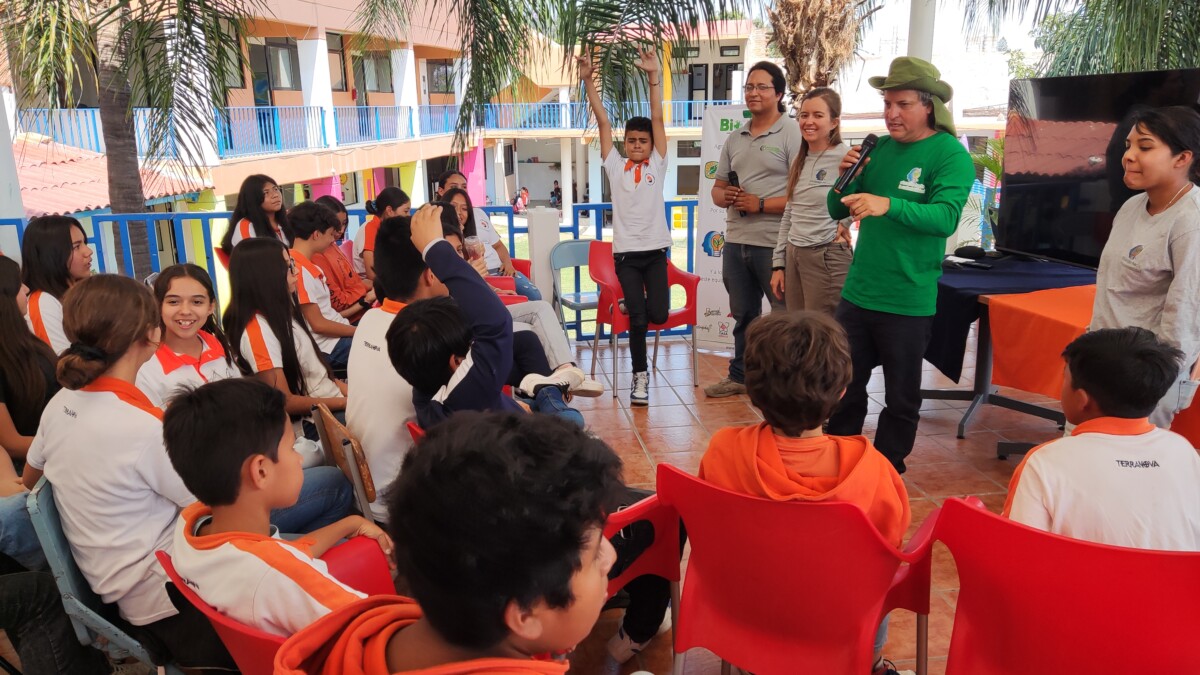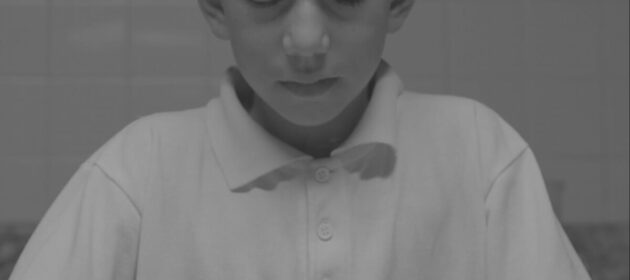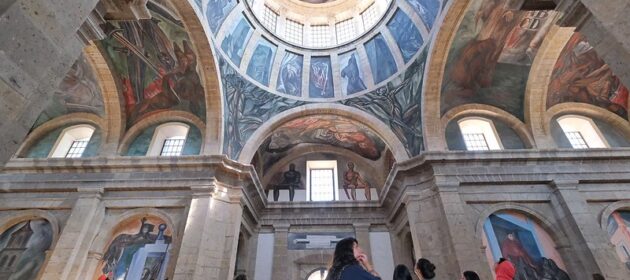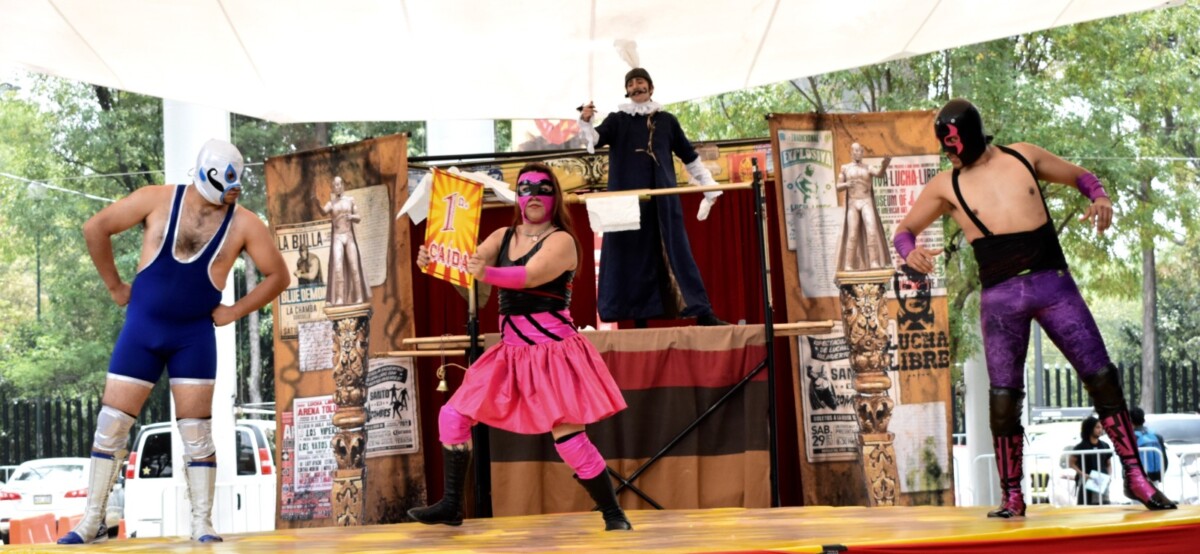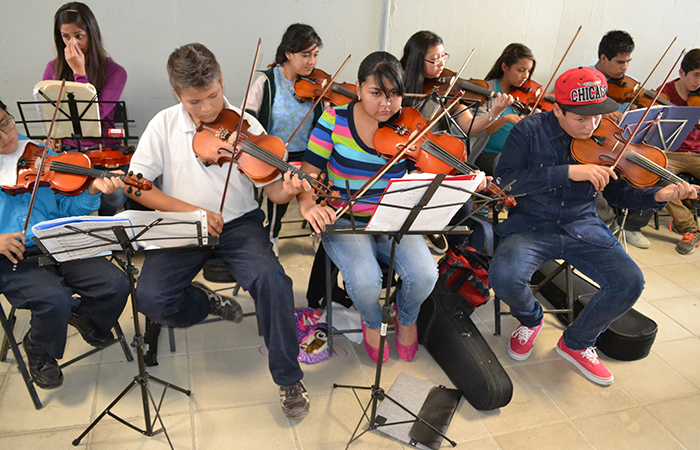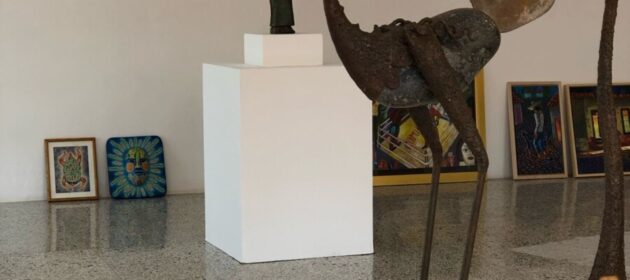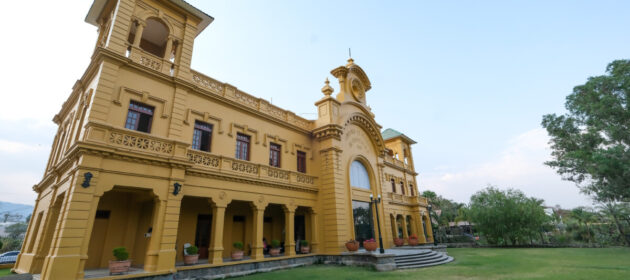cultura
Conmemora el Instituto Terranova el Día de la Tierra con dinámicas y conferencias
La AC, BioTU llevó actividades interactivas pláticas y conferencias para los alumnos del instituto Terranova. Foto: D. Arturo Ortega.
Redacción. – Con dinámicas interactivas, pláticas y conferencias sobre el cuidado del medio ambiente, el Instituto Terranova conmemoró el Día Internacional de la Madre Tierra, el 22 de abril.
Las actividades dirigidas a los alumnos de educación básica y bachillerato incluyeron juegos interactivos para los grados menores, mientras que para los grados superiores se proyectó un video y conferencia que tuvo alrededor de una hora de duración.
Emilio Bernal Maza, director de Educción e Innovación de la Asociación Civil (AC) BioTU, dedicada a la enseñanza de prácticas sustentables y amigables con el medio ambiente, para escuelas y empresas, habló del objetivo de las actividades realizadas con los alumnos:
“La idea general es que se reconecten con su propia naturaleza, que reconozcan a la Tierra como madre y también que nosotros tenemos que cuidarla para que nos retribuya con los servicios que nos da”, comentó el representante de la AC que tiene su sede en la cabecera municipal de Jocotepec.
El Día Internacional de la Madre Tierra fue establecido en 2009 por la Asamblea General de las Naciones Unidas mediante la Resolución A/RES/63/278. La Resolución fue presentada por Bolivia y respaldada por más de 50 estados miembros.
Presentan plan de acción para sanear la cuenca Lerma Chapala en el marco del Día Internacional de la Tierra
El plan se presentó el Día Internacional de la Madre Tierra, en las instalaciones del ITESO, Guadalajara. Foto: Captura de pantalla.
Redacción.- La organización para la conservación del medio ambiente, Instituto Corazón de la Tierra, en colaboración con la Universidad Jesuita de Guadalajara ITESO, presentaron “Plan de Acción para la Cuenca Lerma-Chapala, 2024-2034” para sanear la cuenca del Lago de Chapala en 10 años, durante el marco de la conmemoración del Día internacional de la Madre Tierra.
El plan integra 114 líneas de acción que tienen como propósito atender las causas de la compleja problemática que afecta a ríos y lagos de la cuenca Lerma-Chapala, incluyendo Pátzcuaro, Cuitzeo, Yuriria y Chapala entre otros que conforman las 19 subcuencas que componen la zona de captación.
Dicho plan está diseñado como un instrumento que fortalezca la gobernanza, involucrando tanto a instituciones de gobierno como a sectores de la cuenca, atendiendo aspectos de información, participación, instituciones, políticas de manejo, tecnología y financiamiento, a partir de una Visión de Cuenca que considere las características y complejidades de la misma.
El Plan de Acción se construyó a partir de los insumos obtenidos del Simposio Internacional y Foro Público Cuenca Lerma-Chapala, Soluciones para un Territorio en Crisis, que se llevó a cabo del 22 al 24 de marzo del 2023, en una colaboración entre el Instituto Corazón de la Tierra y el Seminario Permanente en Estudios del Agua el ITESO, con apoyo de instituciones de México y Alemania.
En este foro participaron 80 expertos nacionales y de Alemania, Brasil, Colombia, España, Filipinas y Japón, un conjunto de especialistas en temas de manejo de cuencas y cuerpos de agua, restauración ecológica, gobernanza y financiamiento de proyectos, entre otros temas; además de 77 integrantes de sectores interesados como agricultores, ganaderos, pescadores, prestadores de servicios turísticos y organizaciones civiles, entre otros.
El Lago Chapala es el más grande de México y uno de los más antiguos del planeta. Un ecosistema acuático rico y complejo, que brinda enormes beneficios a millones de personas: agua, regulación del clima, servicios para el turismo, biodiversidad y pesca, entre tantos otros.
Sin embargo, los lagos Chapala, Cuitzeo, Pátzcuaro y otros ubicados en la cuenca enfrentan fuertes amenazas, presentando al menos 15 de los 19 problemas que aquejan a los lagos del planeta, algunos de forma grave. Es por ello que el Plan de Acción servirá, no sólo para encontrar soluciones sino para empujar procesos que las pongan en práctica.
A partir de la primera gran crisis del Lago Chapala en 1955, se trató de implementar “planes maestros” en al menos en 6 ocasiones, con muy poco éxito. Una parte importante de dicho fracaso fue la oposición de diferentes sectores sociales que fueron excluidos de su diseño y los consideraron negativos por una causa u otra.
“Este Plan de Acción para la Cuenca Lerma-Chapala, 2024-2034 se elaboró involucrando a un grupo amplio de expertos y a los sectores que habitan el territorio, en un diseño de gobernanza que busca fortalecer la participación, de forma tal que complemente el ejercicio del gobierno y fortalezca la aplicación de las leyes, la investigación científica, la ciencia ciudadana y las acciones de conservación”, informó a través de un comunicado el Instituto Corazón de la Tierra.
Además, considera que la Cuenca del Lerma Chapala, al ser tan grande y diversa, requiere un planteamiento en unidades de manejo, siendo las más adecuadas sus 19 subcuencas.
“El Plan es para la cuenca, pero requiere adaptarse a las características de cada subcuenca, considerando sus diferencias de ecosistemas, niveles de conservación, actividades productivas, formas de organización, manifestaciones culturales, etc”, agregó el comunicado.
El Plan es un instrumento sólido y flexible que debe ser promovido, implementado y monitoreado en cada subcuenca y en la cuenca Lerma-Chapala en su conjunto, realizando los ajustes que sean necesarios. Tiene un enfoque adaptativo y sigue un conjunto de lineamientos internacionales, entre los más importantes los Objetivos de Desarrollo Sustentable de la Organización Mundial de las Naciones Unidas (ONU), y la Resolución de Manejo Sustentable de Lagos aprobada en 2022, que es de cumplimiento vinculante para los países miembros de esta agencia internacional. En los aspectos de gobernanza sigue los lineamientos del International Lake Environment Committee Foundation (ILEC), la red de científicos y gestores de cuencas lacustres más importante del planeta.
Lo que sigue es un trabajo intenso de presentación del Plan de Acción de la Cuenca Lerma Chapala 2024-2034 ante sectores de interés e instancias gubernamentales de nivel nacional, del Estado de México, Querétaro, Guanajuato, Michoacán y Jalisco, así como la construcción de alianzas para canalizar recursos que permitan implementar las 114 líneas de acción identificadas.
Se proyectará el cortometraje ribereño ‘Cuete’ en el Festival Internacional de Cine de Tequila
“Cuete” es la historia de Ángel, un niño que anhela tener un caballo. Foto: Carmen Carolina.
Redacción.- La historia de un niño de Ajijic que sueña con tener un potrillo se proyectará en el Festival Internacional de Cine de Tequila (FICTEC) en su octava edición en la que tendrá a Francia como país invitado.
El cortometraje ‘Cuete’ de la joven directora Carmen Carolina que se grabó por completo en localidades del Pueblo Mágico de Ajijic y San Juan Cosalá en el 2023 y fue seleccionado para participar en la sección de ‘Mujeres Jaliscienses’.
El corto que tiene una duración de 23 minutos se proyectará el próximo jueves 25 de abril a la 1:00 de la tarde en la Casa de la Cultura de la capital del Tequila, que se ubica en la calle Lerdo de Tejada 25 de la cabecera municipal.
Calificado por su autora dentro del género del realismo mágico, el corto en blanco y negro fue estrenado dentro del primer Chapala Indie Film Festival (CIFF) realizado en el Centro para la Cultura y las Artes de la Ribera en 2023 y en la actualidad busca proyectarse a través de varios festivales de cine en Europa y México.
El corto está protagonizado por habitantes de Ajijic y está ambientado en una zona rural donde los personajes convergen en un ambiente de cotidianidad, mezclado con la fantasía de Ángel, un niño que anhela tener un caballo y hace de todo para conseguirlo.
Al material fílmico ya se ha proyectado en varias localidades de la ribera de Chapala y próximamente podrá verse al aire libre en el malecón de la delegación de San Antonio Tlayacapan, municipio de Chapala, el 27 de abril a partir de las 7:00 PM y en el malecón de Ajijic, el 25 de mayo a la misma hora como parte de la gira del CIFF.
Digitalizan el Museo Cabañas y los murales de José Clemente Orozco para audiencias globales
La arquitectura Museo Cabañas y los murales de José Clemente Orozco para audiencias globales ya están disponibles en la aplicación Google Arts and Culture. Foto: Cortesía.
Redacción.- La plataforma Google estrenó las vistas en Street View del Museo Cabañas y sus murales, dentro de un proyecto de sitios Patrimoniales de la UNESCO en la aplicación Google Arts and Culture. Este lanzamiento pone al alcance de audiencias globales el patrimonio cultural del Estado de Jalisco y la obra de José Clemente Orozco.
A través de las herramientas de la plataforma, como las exposiciones digitales e inmersivas y los recorridos en 360º, los públicos nacionales e internacionales pueden recorrer desde la comodidad de su casa la arquitectura neoclásica, los 57 frescos realizados por el muralista José Clemente Orozco, incluida la que es considerada su obra maestra, El Hombre en Llamas, en la cúpula de la capilla central, así como los 23 patios del museo, declarado patrimonio cultural de la humanidad en 1977.
Se trata de un esfuerzo de más de año y medio de trabajo en conjunto con Google para conseguir la calidad de las tomas y así ofrecer a las personas interesadas, una experiencia digna de uno de los recintos y artistas más emblemáticos del estado de Jalisco.
El lanzamiento del Street View enmarcado en el Patrimonio Mundial de la UNESCO tiene un gran potencial de difusión, con una ventana de exposición de más de 50 millones de personas y al compartir escenario con importantes inmuebles de todo el mundo, como el Sitio Arqueológico de Kernavé, en Lituania, la Ciudad Medieval de Rodas y Delos, Grecia, entre otros.
Para recorrer el interior del Museo Cabañas sin salir de tu casa, solo tienes que ingresar al perfil de la UNESCO en Google Arts and Culture, dando clic en el enlace: https://artsandculture.google.com/project/explore-world-heritage
Llegará la lucha libre a la plaza de Ajijic
Escena de la obra La Gran Lucha del Mundo. Foto: Cortesía.
Redacción.- ¿Te gusta la lucha libre? No te pierdas la obra de teatro “La Gran Lucha del Mundo” que se realizará este viernes 19 de abril a las 18:30 horas en la plaza principal de Ajijic como parte de las actividades extramuros del Centro para la Cultura y las Artes de la Ribera (CCAR). ¡Sin costo!
La Gran Lucha del Mundo, Auto Sacramental Pagano y contemporáneo, es una puesta en escena que sigue con la tradición de la lucha libre mexicana y que se vuelve un medio de diálogo directo con el público; los personajes pueden ir al encuentro del espectador e irrumpir en el espacio público.
En esta ocasión, La Quinta Teatro y Al Rescate unen fuerzas para llevar a escena dos expresiones profundamente arraigadas en la identidad nacional mexicana: el vibrante colorido y la emocionante lucha libre.
Buscan reparar instrumentos musicales de Cultura Jocotepec
Alumnos del programa ECOS. Foto: Gobierno de Jalisco.
Armando Esquivel.- El cabildo de Jocotepec aprobó una firma de convenio con la Secretaría de Cultura de Jalisco, comprometiéndose a destinar recursos para el arreglo de instrumentos musicales y así poder beneficiarse de un apoyo por 80 mil pesos.
La firma del convenio fue aprobada durante décima sesión ordinaria de cabildo, celebrada el 10 de abril, en la que se acordó el destinar un monto de erogación municipal por 29 mil 615 pesos, mismos que serían usados para el arreglo de instrumentos de cuerdas, percusiones, así como teclados y herramientas como equipo de sonido y cables, que son parte del inventario de instrumentos de Casa de la Cultura Jocotepec.
Con esto se podrá acceder a un recurso por el monto de 80 mil pesos destinados a cultura, a través del programa “ECOS, Música para la Paz”, que busca impulsar el talento músical en menores para alejarlos de la delincuencia y las adicciones.
Expondrán siete referentes de la plástica de Ajijic en el CCAR
Montaje de la exposición HORIZONTES. Foto: Cortesía.
Redacción.- La muestra «HORIZONTES: Siete trayectorias de la plástica en Ajijic», que reúne el trabajo de los artistas Antonio Cárdenas, Alejandro Martínez, Jesús López Vega, Antonio López Vega, Dionicio Morales, Juan Navarro y Daniel Palma, se inaugurará el 20 de abril a las 16:00 horas en el Centro para la Cultura y las Artes de la Ribera (CCAR).
La exposición colectiva busca reconocer la trayectoria de los siete artistas locales que forman parte del legado artístico de Neill James por su papel fundamental en el tejido cultural de la región, dejando una huella indeleble en la escena cultural de Ajijic.
El trabajo de estos artistas ha sido fundamental para enriquecer el imaginario colectivo, capturando la esencia y la diversidad de la expresión creativa arraigada en nuestra comunidad, desde pintura hasta escultura, pasando por fotografía y arte conceptual, el «Legado Neill James» representa una celebración de la multiplicidad de formas en que el arte puede manifestarse.
La exhibición, curada por el artista plástico Ricardo Xavier Cortés Fernández, ofrecerá a los asistentes la oportunidad de sumergirse en el mundo único de cada artista, explorando sus inspiraciones, técnicas y visiones. Además, será una ocasión especial para honrar y reconocer las contribuciones significativas que estos talentosos individuos han hecho a lo largo de sus carreras.
La inauguración de la exhibición tendrá lugar el sábado 20 de abril a las 16:00 horas en la Sala de Exposiciones del Centro para la Cultura y las Artes de la Ribera, ubicado en La Floresta de Ajijic. La entrada es libre.
Festejan los 104 años de la Estación del Tren de Chapala
Centro Cultural González Gallo. Foto: Cortesía.
Redacción.- El 8 de abril se cumplen 104 años de la construcción de la Estación del Tren de Chapala, ahora sede del Centro Cultural González Gallo, por lo que se realizarán una serie de actividades para conmemorar este aniversario el próximo 13 de abril, de las 17:00 a 19:00 horas.
La actividad central será la presentación del libro “La estación de Chapala” del escritor y editor, Martín Casillas de Alba, documento que ha trabajado desde hace dos años y que en coordinación con la fotógrafa Cristina Kahlo fue publicado por la editorial El Globo.
En la presentación el autor estará acompañado por la fotógrafa Cristina Kahlo, así como por la directora del Centro Cultural González Gallo, Gabriela Serrano, la académica Guadalupe Morfín, la arquitecta Arabella González y el arquitecto y paisajista, Mario Schjetnan.
Tras la presentación del libro, la Orquesta Típica Chapala, bajo la dirección de Javier Raygoza Munguía, compartirá una obra musical titulada “Son del tren”, en honor a la estación ahora alberga al centro cultural. Y por último, se llevará a cabo la actividad “Anecdotario”; en donde los invitados rescatarán las memorias del edificio.
El objetivo de la celebración es involucrar a los miembros de la comunidad cercana al inmueble, el cual se transformó en el Centro Cultural González Gallo durante 2006 y que, desde el 2019 forma parte de la Red de Museos de Jalisco.
Para saber más:
Martín Casillas de Alba es un escritor, editor y académico que fue miembro fundador así como editor de El Economista hasta 1994. Actualmente imparte talleres de liderazgo basados en Shakespeare, publica una columna en El Informador de Guadalajara y lleva un blog llamado Juego de espejos.
Cristina Kahlo es una curadora, galerista y fotógrafa enfocada en la fotografía arquitectónica. Entre sus imágenes destacan la documentación fotográfica del Palacio de las Bellas Artes de la CDMX, la Casa Luis Barragán de Tacubaya, el Museo Casa Estudio Diego Rivera y Frida Kahlo, el Museo de la Filatelia de Oaxaca, las tiendas Liverpool, Unidades Habitacionales Fovisste y recientemente las dos casas estudio de la pintora norteamericana Georgia O´Keeffe.
…
Se verá el eclipse solar en la Ribera el próximo 8 de abril
Eclipse anular (anillo de fuego) visto el año pasado desde Campeche, México. Foto: Cortesía.
Patrick O’Heffernan.- El lunes 8 de abril la Ribera de Chapala será un lugar privilegiado para ver el eclipse de sol, visible en toda Norteamérica, y muy visible en el centro de México. El sol comenzará a desaparecer a las 10:50 de la mañana y no reaparecerá completamente hasta la 1:32 de la tarde.
La última vez que observamos un eclipse total de sol en México fue el 11 de julio de 1991, y el próximo no ocurrirá sino hasta el 30 de marzo de 2052, según Eclipse Total de Sol en México, de la Universidad Nacional Autónoma de México (UNAM). Otro eclipse parcial será visible en partes de México este octubre.
Un eclipse solar ocurre cuando la Luna pasa entre la tierra y el sol, oscureciendo la imagen del sol desde la Tierra. Un eclipse solar total se produce cuando el diámetro aparente de la luna es mayor que el del sol, bloqueando toda la luz solar directa, convirtiendo el día en oscuridad. El eclipse del 8 de abril será casi total, un 92%, cuando se vea desde la Ribera.
El eclipse durará más de dos horas, pero la parte de la totalidad del evento será corta; el periodo más largo será de 4 minutos y 28 segundos, cerca de las localidades mexicanas de Nazas, Durango, y Torreón, Coahuila. En Guadalajara, el eclipse comenzará cuando el sol comience a ponerse detrás de la luna, a las 10:50 horas, alcanzará su punto máximo de 92% de oscuridad a las 12:09 horas y terminará a la 1:32 – un total de 2 horas y 42 minutos-. La oscuridad total del eclipse será de 4 minutos y 20 segundos en la Ribera.
En Lakeside News se están organizando fiestas privadas para ver el eclipse, incluido un brunch con burbujas para recaudar fondos para Los Niňos Incapacitados (agotadas al cierre de esta edición). Se advierte a las personas que planean ver el eclipse que no miren directamente al sol, ya que esto puede causar daños permanentes en los ojos. Utilice únicamente gafas certificadas para ver el eclipse. Las gafas de sol normales no le protegerán los ojos.
Galardona DIF Jocotepec a sus ex titulares
Ex titulares del DIF Jocotepec que recibieron su galardón. Foto: Cortesía.
Armando Esquivel.- El Sistema DIF Jocotepec entregó un galardón a quienes fungieron alguna vez como titulares de la dependencia, develando también fotografías de las ex funcionarias públicas en una ceremonia realizada el 21 de marzo.
Fueron 14 las personas galardonadas, en una ceremonia realizada en casa de cultura y en la que estuvo la presidenta de la dependencia, Dilia Ibarra Espinoza y su esposo, el alcalde de Jocotepec, José Miguel Gómez López.
Para rendir homenaje, el DIF entregó galardones a las personas ex titulares de entre 1971 y el 2024, realizando también el montaje de una fotografía en un marco para ser expuestas las imágenes dentro de la casa de la cultura jocotepense.
Durante el homenaje, realizado en el marco del Día Internacional de la Mujer, las y los presentes tuvieron una surtida barra de aperitivos y canapés, mientra que días atrás, el organismo encargado de la asistencia social pública y protección a las personas y familias en condiciones de vulnerabilidad, realizó un adornado desayuno para las ex funcionarias, que también fue aprovechado por algunas personas dedicadas a la función pública.
© 2016. Todos los derechos reservados. Semanario de la Ribera de Chapala


